Click here to print
Work Continues on a Film Trove in Jordan
posted August 14, 2012
A few years ago, an artist living in Amman, Jordan, saved a trove of 881 film cans and their contents from a trash pile at the defunct Russian Cultural Center.
The Royal Film Commission Jordan agreed to store them, and they sat in a garage on a busy market street, largely forgotten.
Eventually they came to the attention of Matthew Epler, an American visual artist and New York University graduate student who was teaching at the Red Sea Institute of Cinematic Arts, in Aqaba. “Within them could be (and most likely are) clues of serious cultural significance leading from this dusty garage all the way to the USSR and back again,” Epler wrote in MIAN in 2010.
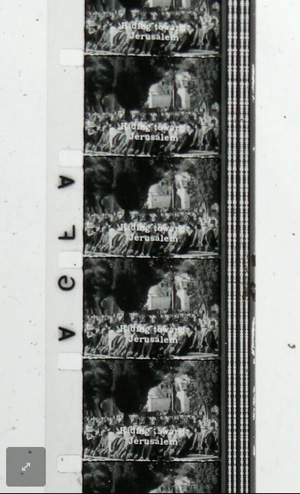 Epler took on the task of preserving the films because he was aware that Jordan, a country with little current film industry, and a history of theatres closing by the score to be replaced by pirated copies of Hollywood blockbusters for home consumption, might become the collection’s graveyard.
Epler took on the task of preserving the films because he was aware that Jordan, a country with little current film industry, and a history of theatres closing by the score to be replaced by pirated copies of Hollywood blockbusters for home consumption, might become the collection’s graveyard.
He soon discovered that the trove contained both 35mm and 16mm films. The 35mm prints were largely Russian fiction features with Arabic and sometimes English and French subtitles. The cans’ labels were all in Russian, and indicated that the material dated from the 1930s to the 1980s, and in most cases came from SovExportFilm, a Soviet-era agency that exported films around the world.
The 16-mm items were primarily documentary films, from the Jordanian Ministry of Culture and Information, or from independent filmmakers, in cans labeled by hand, in Arabic. They were locally produced, “a historically significant find for Jordan,” Epler noted.
Important, too, was some of the footage Epler quickly found. Among items identified so far:
• A documentary confirmed to be part of the PLO Film Archive, lost since 1985.
• Footage of King Hussein in 1968 addressing the United Nations in the aftermath of the Six Day War.
• Documentary footage of Jerusalem in 1968 and its aftermath.
• Unidentified propaganda films from Vietnam made to highlight relations among Vietnam, Russia, and political activists in the Middle East in the 1960s and 1970s.
• Russian feature films sent as part of a cultural exchange between Russian and Arab partners, ranging from the 1920s to the 1980s.
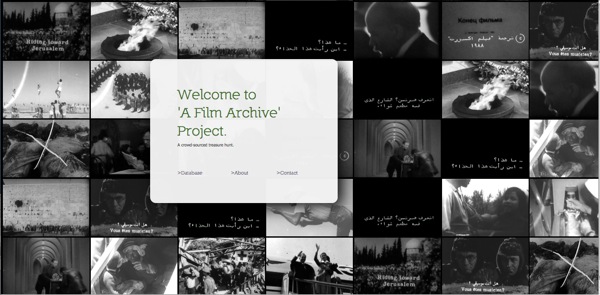
Epler sought help in identifying the films and, more urgently, finding a safer location. His goal has been to digitize the films, and post them freely online for researchers and other interested parties.
In 2010, he and colleagues photographed the lids of the 881 cans. They posted images from the cans to a Picasa photo gallery, hoping that film archivists and others might be able to help him answer his questions. He put out the word that anyone interested in helping to translate the Russian text, or who had leads of any kind, should get in touch. He created a database for that purpose.
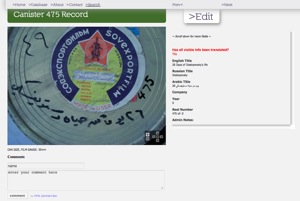 Since that time, Epler has found several sources of assistance. “There has been little to no response from any authorities,” he says, “but several individuals have stepped forth to express their interest. Among them are Oraib Toukan, a Palestiniant-Jordanian artist, Kay Dickinson from the University of London who studies Arab cinema, and Peggy Awesh and her students at Bard College. We’ve also had support from NYU’s Moving Image and Archiving Program.”
Since that time, Epler has found several sources of assistance. “There has been little to no response from any authorities,” he says, “but several individuals have stepped forth to express their interest. Among them are Oraib Toukan, a Palestiniant-Jordanian artist, Kay Dickinson from the University of London who studies Arab cinema, and Peggy Awesh and her students at Bard College. We’ve also had support from NYU’s Moving Image and Archiving Program.”
Awesh and her Bard students have done a great deal of the translating and the project has also benefitted from bursts of help from interested PhD candidates and general enthusiasts who speak Russian or Arabic doing a few titles at a time.
Epler says: “I had a very enthusiastic response from a PhD candidate in Beirut, Sabah Haider, who wants to take on the task of finding out exactly how these titles came to be in Jordan and why. She will work in tandem with Kay Dickinson and other people focusing on this kind of research.”
With all that, 600 of the 850 cans have now been translated. A list of the titles in Englishis online.
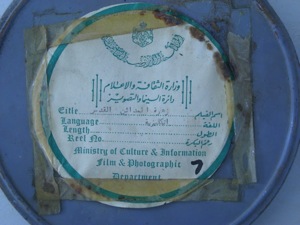 “It’s great to call upon other people’s interests and enthusiasm especially when its mutually beneficial for everyone involved,” says Epler. “Sabah will have a great body of research and an exciting project to propel her academic career, and the films will be one step closer to a safe home. In that way, this project showcases what crowd-sourcing can really achieve.”
“It’s great to call upon other people’s interests and enthusiasm especially when its mutually beneficial for everyone involved,” says Epler. “Sabah will have a great body of research and an exciting project to propel her academic career, and the films will be one step closer to a safe home. In that way, this project showcases what crowd-sourcing can really achieve.”
Finding funding has proven difficult, as Epler imagined it would be. “We need a lot of help navigating the options for funding. It’s also a tricky situation when you’re asking for money and not offering full ownership of something like a historical collection of film. It’s important to me that these aren’t swallowed up by a single institution that will inevitably limit access to the footage. The whole point is to keep these fully accessible to everyone, and that’s totally possible if the right institution or funding were to come along.”
In a significant step, 11 of the reels have been digitized and released, online (see, end of this article). Eventually, Epler and his colleagues hope to make preservation-quality digital copies of all the films, and to provide similar online viewing access to them. He is trying to organize an advisory board of filmmakers, scholars, historians, and community leaders, to oversee the preservation project. They will also be asked to find “stakeholders” with knowledge, resources, and financial means of support.
Long-term goals include construction of a permanent archive to house the films already found, and others that are located. It would make high-definition copies of such films for research and viewing.
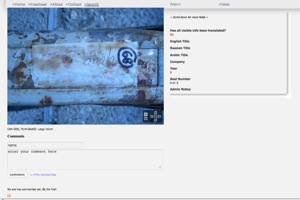 A for-profit archive may also be in the future, to capture interest in Middle East and North African film among broadcasters around the world. High-resolution scans of films would be licensed to networks, production companies, and institutions. Profits would help support the archive.
A for-profit archive may also be in the future, to capture interest in Middle East and North African film among broadcasters around the world. High-resolution scans of films would be licensed to networks, production companies, and institutions. Profits would help support the archive.
Epler continues to be certain that the current collection is unusual. “We haven’t come across anyone claiming to have a collection similar to this. There is evidence, however, that private individuals house the remains of old collections. My first glimpse of this was through Azza El-Hassan’s documentary Kings and Extras, which attempts to trace the history of the lost PLO film archive.
“I was also introduced to a great project in Mexico called Archiva Memoria that offers digitization services for private film collections – with an emphasis on home movies – in exchange for keeping a copy of the film. We are exploring options similar to that to bring the lost films out of the shadows. To do that, we need some more infrastructure first: equipment, space, staff, etc. We hope to build up to this one small step at a time by first properly assessing what we have, identifying the good stuff, and releasing it in a way that will attract attention to the need for this work in the region and others like it.”
As always with old film stock, delay does not help. Fortunately, atmospheric conditions in Amman are relatively mild. “The terrain is mostly very hot and very dry,” says Epler, “but there are surprising variations. Beirut gets a fair amount of rain, for example. In Amman, where the films have been for decades, it gets cold enough to snow. The one advantage is the lack of humidity. The films are in surprisingly good shape. If people are interested, I photographed the head/tail of about 10 reels. If they go to the original Picasa site and look for anything between 35mm #1 and 35mm #100 (located at the bottom), they can see the film stock itself and the conditions of perfs, etc.”
Epler presented the project at the Orphans 8 Symposium this past Spring at the Museum of the Moving Image. The warm response encouraged him and his colleagues to start Facebook and Twitter accounts to keep track of supporters.
In May 2012, Leah Caldwell, a journalist with a Beirut newsletter Al Akbhar, wrote a thorough article about the collection.
Says Epler: “We’ve also written an outline for the next steps and are seeking funding for basic equipment, which is completely absent in Jordan. Our eventual goal is to start a real archive in Amman that will be the collection center for orphaned film prints from all over the region.”
11 Films Now Available Online
King Hussein in Russia (feat. Queen Rania) – 35mm
n
“Jordanian Report” – 35mm
n
Russian Fiction Feature (MosFilm) – 35mm
n
Russian Fiction Feature – 35mm
n
King Hussein in Russia (feat. Queen Rania) – 35mm
n
Russian Fiction Feature – 35mm
n
“The Palestinian Right” – 16mm
n
King Hussein in Russia (feat. Queen Rania) – 35mm
n
“Exodus 1967” (feat. King Hussein) – 16mm
n
Unknown Vietnamese Communist Film (1970) – 16mm?
n
“Hanh, a Teacher” (Vietnam) -16mm
The project’s collection of photographs of the recovered film canisters is online. To receive updates or for general inquiries, email info@afilmarchive.net
Matthew Epler is a graduate of USC’s School of Cinematic Arts and a current master’s candidate at NYU’s Interactive Telecommunications Program. He was a founding faculty member of the Red Sea Institute of Cinematic Arts in Jordan where he taught film history and theory for three years.
– Peter Monaghan
Printed from Moving Image Archive News: http://www.movingimagearchivenews.org
URL to article: http://www.movingimagearchivenews.org/work-continues-on-a-film-trove-in-jordan/
Click here to print